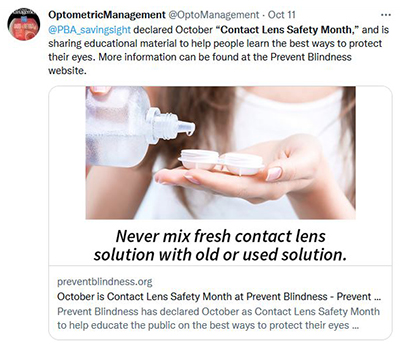With Halloween just two weeks away, it’s a good time for ECPs to talk with patients about contact lens safety and the dangers of wearing lenses that are dispensed without an eye exam or a prescription. According to the Food and Drug Administration, wearing decorative contact lenses can be risky and wearing any kind of contact lenses, including decorative ones, can cause serious damage to your eyes if the lenses are obtained without a prescription or are not used correctly. Here are some of the things that can go terribly wrong with your eyes when wearing decorative or cosmetic contact lenses sold in stores or online.
● A cut or scratch on the top layer of your eyeball (Corneal Abrasion)
● Allergic reactions like itchy, watery red eyes
● Decreased vision
● Infection
● Blindness
Anyone interested in purchasing contact lenses must first receive an eye exam from a licensed eyecare professional. All contact lenses are classified by the U.S. Food and Drug Administration (FDA) as prescription medical devices. This applies to prescription and non-prescription (cosmetic or decorative) contact lenses.
The FDA also states that contact lenses are not over-the-counter devices. Companies that sell them as such are misbranding the device and violating Federal Trade Commission regulations by selling contact lenses without a prescription. Contact lenses sold without a prescription from unlicensed vendors may be contaminated and/or counterfeit and are therefore not safe to use.
The American Academy of Ophthalmologists said although it’s tempting to use decorative contact lenses for Halloween, consumers should consider skipping the decorative contact lenses and rock glasses instead with these fun Halloween glasses-wearing characters: Dr. Fauci, Where’s Waldo, Mirabel from Encanto, Stranger Things characters, Harry Potter or Velma from Scooby Doo.
Misusing contact lenses is top of mind around this time of year, but safely handling contact lenses is also a year-round concern, which is why Prevent Blindness has declared October as Contact Lens Safety Month to help educate the public on the best ways to protect their eyes through proper care. In addition to a dedicated webpage, fact sheets and shareable social media graphics, Prevent Blindness also offers the “Contact Lens Safety” episode as part of the Focus on Eye Health Expert Series. Dr. Thomas L. Steinemann, professor of ophthalmology at Case Western Reserve University, discusses a variety of topics with Prevent Blindness president and CEO, Jeff Todd, including advocating for contact lens safety, patient care, and the dangers of improper use of contact lenses.
The American Academy of Ophthalmology recently presented Dr. Steinemann with the “Outstanding Advocate Award,” recognizing his leadership and advocacy efforts spanning two decades in promoting patient safety and contact lens use.
According to Prevent Blindness, different types of contact lenses include:
-
Soft contact lenses come in two basic forms—daily wear and extended wear. Both lenses are made from thin, flexible material and water. Daily-wear lenses must be removed, cleaned, and stored every day. Extended-wear lenses are designed for overnight wear. However, there is an increased risk of infection associated with extended-wear lenses. They should be worn for the period of time prescribed by an eye doctor.
 |
|
|
|
- Hard contact lenses offer clearer vision with certain eye conditions, and specific types may last longer. Many types of hard contact lenses are available in bifocals. It may take longer to adapt to wearing hard contact lenses than soft contact lenses.
- Daily-wear soft lenses are generally the most comfortable, and the eyes will adjust to wearing them in less time than with hard contact lenses. Soft lenses may be worn during vigorous physical activities and playing sports with less likelihood that the lenses will slip out of place. Soft contact lenses need special cleaning and disinfection and may tear easily, so they may not last as long as hard contact lenses.
- Extended-wear soft lenses offer the same advantages as daily-wear lenses. These lenses may be worn for an extended period, up to a week. However, due to the risk of infection associated with extended use, daily removal and cleaning is recommended.
A recent study published in Ophthalmology, “Acanthamoeba Keratitis Risk Factors for Daily Wear Contact Lens Users,” found that those who use reusable contact lenses rather than disposable daily lenses are four times more likely to develop Acanthamoeba Keratitis, a severe, painful infection of the cornea, the transparent outer covering of the eye, which usually causes scarring.
If undiagnosed and untreated, this can lead to blindness. In the most severe cases, a corneal transplant may be necessary. The infection is believed to be caused through exposure of the eye to water contaminated with acanthamoeba, a free-living microscopic organism.
Prevent Blindness offers the following recommendations to keep eyes healthy while wearing contact lenses:
-
Before handling contact lenses, wash hands with soap and water, then rinse and dry them with a lint-free towel.
- Minimize contact with water, including removing lenses before going swimming or in a hot tub.
- Wear and replace contact lenses according to the schedule prescribed by your eyecare professional.
- During cleaning, using fresh solution, rub your contact lenses with your fingers, then rinse the lenses with solution before soaking them—even if the solution you are using is a “no-rub” variety.
- Contact lens cases should always be cleaned with fresh solution—not water. Then leave the empty case open to air dry.
- Do not reuse old solution or “top off” the solution in your lens case.
- Do not use cracked or damaged lens cases. Lens cases can be a source of contamination and infection.
“Whether you wear contact lenses to improve vision, or as part of a costume, it is so important to make sure you do so under the guidance of an eyecare professional,” said Todd of Prevent Blindness. “Following safety routines every day can help prevent painful and potentially sight-threatening infections.”
For more information and tips on contact lens safety, visit https://preventblindness.org/wearing-contact-lenses/.